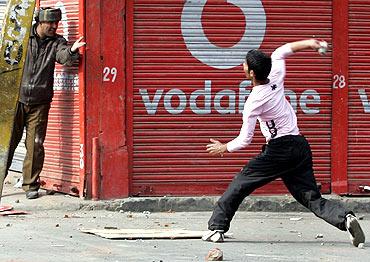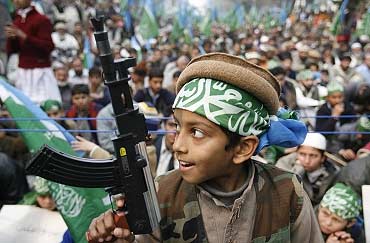 | « Back to article | Print this article |
Kashmir: The story no one wants to tell
The slogan 'Khoon ka badla June mey' (the murders of 2010 shall be avenged in the summer of 2011) had instilled fear in the hearts of all those who wished well for Kashmir.
In all honesty, this is what brought me to Srinagar this June. I wanted to see for myself that the people who least wanted that slogan to be put into effect were the Kashmiris themselves, especially, the people of Srinagar who bore the maximum brunt of protests and police action last summer, over 130 dead and double the number injured; millions lost in revenue and children forced to miss almost two semesters of schooling.
But in June 2011, the story is diametrically opposite. There are no outstation journalists; just outstation tourists here. The airport is unable to handle the heavy influx of tourists from all over India. Hotels are running at 100 per cent occupancy.
Click NEXT to read further'Authorities are afraid of attracting bad luck'
Authorities fight shy of giving numbers, as they are scared of attracting bad luck or the attention of militants or India's good neigbour, who might find this an ideal time to up the ante and "cause an incident".
The Chief Minister, Omar Abdullah, quickly knocked on his intricately carved wooden table, for good luck, when I congratulated him over the successful culmination of Panchayat (village local body) elections and the massive influx of tourists.
He said his next big challenge was to ensure that the Amarnath pilgrimage passes off peacefully. Over a quarter million Hindu pilgrims are expected to arrive in Kashmir to visit the holy ice shivling in the Amarnath Cave, which is opened only for about one month in a year.
Click NEXT to read further
'Some say he is a leader of stone throwers'
About six kilometers from the chief minister's classy and well-appointed residence, is another residential area, which stands out simply because of the lack of any state security. Yet, the houses here have 10 feet high walls and then razor wires above those walls. There are no private security guards either, no cars parked outside the gates, not much traffic on the narrow roads.
I have an appointment with a person who goes by many identities. Some say he is a leader of stone throwers, others say he is a youth leader, and many others claim that he has dubious connections with militants or former militants.
I wait at the imposing gates, hoping to be let in. There is a camera to which my interlocutor speaks in Kashmiri trying to convince the person that I genuinely do have an appointment with Asif (name changed). The thick gates (I am sure it can withstand a minor explosion) open.
Parked in the driveway are two cars with darkened windows; rose bushes growing wild, and several satellite dishes dot the landscape. There is an eerie stillness, no noise of children or traffic, or of music from the neighbouring houses.
Click NEXT to read further
'The discontentment was channeled by the separatists for their ends'
Stern looking young men usher me in reluctantly to the narrow staircase leading to a sitting room where there are toys and electronic gadgets strewn around. It looks lived in, but I can't see the presence of any wife or children. There are no photographs around and there is no smell of any food being cooked. Tea and biscuits are brought in by male staff that looks annoyed by my presence.
Asif is positively gregarious. He does not try to hide his past. Here is an excerpt of what he told me.
"I am not going to say to you that the stone pelters did wrong. They were misguided. They had energy, they were angry and didn't know how to say No, when money was offered for a seemingly non-dangerous assignment."
"This discontentment was channeled by the separatists for their ends. For example if the separatist got 500,000 rupees from Pakistan or the other Muslim countries, which fund the separatist movement, they distributed 100,000 to each leader," he said.
Click NEXT to read further
'We were all pawns in the Kashmir azadi game'
"They in turn paid each young boy 5,000 rupees to throw stones. Those young 16-18 year old boys who were sitting at home because of schools being closed due to bandh calls by separatists, and who have little job prospects, with nothing to do and fed on azadi slogans, picked up stones without realising that they were being used as pawns. We all did it," he said.
"Now, those boys are either dead or in jail for the past several months under the PSA Act (Public Safety Act). But those who sent them to throw the stones are still getting money from both the Indian and Pakistani governments," he added.
"They still travel abroad whenever they want, they attend international conferences, the interlocutors meet them, and their children are studying in Delhi. Yes, I am talking about all the Hurriyat leaders. What fools they have made of you Indians and Pakistanis," he said.




